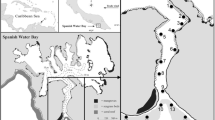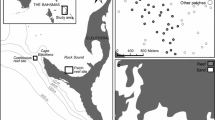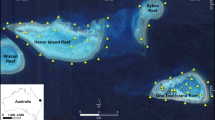Abstract
We assessed small-scale movement patterns of fishes on three eastern Tasmanian reefs by divers visually resighting 1 040 individuals of 16 species marked with unique colour-coded tags. With the possible exception of the monacanthid Acanthaluteres vittiger, common species showed high fidelity to site, with individuals generally resighted <100 m from the initial tagging site and remaining near the tagging site throughout the 1 year duration of study. The wrasses Pictilabrus laticlavius and Notolabrus tetricus were more sedentary than Notolabrus fucicola and the monacanthids Meuschenia australis and Meuschenia freycineti. Body length, sex, water temperature and time since tagging had little influence on distance moved compared to variation between individuals, other than movement distance increasing with body length for N. tetricus. Movement patterns were generally consistent at all three sites, although mean distance moved by N. fucicola was double at Swanport and Return Point compared to Lobster Point. N. tetricus but not P. laticlavius emigrated from areas artificially cleared of macroalgae. The sedentary nature of most small- to medium-sized reef fish species, particularly labrids, indicates that relatively small (≈1 km diameter) marine protected areas should generally provide conservation benefits for these fishes but few `spillover' benefits in surrounding areas.
Similar content being viewed by others
References
Attwood, C.G. & B.A. Bennett. 1994. Variation in dispersal of galjoen (Coracinus capensis) (Teleostei: Coracinidae) from a marine reserve. Can. J. Fish. Aquat. Sci. 51: 1247-1257.
Attwood, C.G. & B.A. Bennett. 1995. Modelling the effect of marine reserves on the recreational shore-fishery of the south-western Cape, South Africa. S. Afr. J. Mar. Sci. 16: 227-240.
Babcock, R.C., S. Kelly, N.T. Shears, J.W. Walker & T.J. Willis. 1999. Changes in community structure in temperate marine reserves. Mar. Ecol. Prog. Ser. 189: 125-134.
Barrett, N.S. 1995. Short and long-term movement patterns of six temperate reef fishes (Families: Labridae and Monacanthidae). Mar. Freshw. Res. 46: 853-860.
Boje, J. 2002. Intermingling and seasonal migrations of Greenland halibut (Reinhardtius hippoglossoides) populations determined from tagging studies. Fish. Bull. 100: 414-422.
Buxton, C.D. & J.C. Allen. 1989. Mark and recapture studies of two reef sparids in the Tsitsikamma Coastal National Park. Koedoe 32: 39-45.
Cappo, M. 1995. The population biology of the temperate reef fish Cheilodactylus nigripes in an artificial reef environment. Trans. R. Soc. Aust. 119: 113-122.
Chapman, M.R. & D.L. Kramer. 1999. Gradients in coral reef fish density and size across the Barbados Marine Reserve boundary: Effects of reserve protection and habitat characteristics. Mar. Ecol. Prog. Ser. 181: 81-96.
Chapman, M.R. & D.L. Kramer. 2000. Movements of fishes within and among fringing coral reefs in Barbados. Environ. Biol. Fish. 57: 11-24.
Cole, R.G., E. Villouta & R.J. Davidson. 2000. Direct evidence of limited dispersal of the reef fish Parapercis colias (Pinguipedidae) within a marine reserve and adjacent fished areas. Aquat. Conserv. Mar. Freshw. Ecosyst. 10: 421-436.
Connolly, R.M., A.J. Melville & K.M. Preston. 2002. Patterns of movement and habitat use by leafy seadragons tracked ultrasonically. J. Fish Biol. 61: 684-695.
Corless, M., B.G. Hatcher, W. Hunte & S. Scott. 1997. Assessing the potential for fish migration from marine reserves to adjacent fished areas in the Soufriere Marine Management Area, St. Lucia. Proc. Gulf Caribb. Fish. Inst. 49: 71-98.
Eckert, S.A. & B.S. Stewart. 2001. Telemetry and satellite tracking of whale sharks, Rhincodon typus, in the Sea of Cortez, Mexico, and the north Pacific Ocean. Environ. Biol. Fish. 60: 1-3.
Edgar, G.J. & N.S. Barrett. 1997. Short term monitoring of biotic change in Tasmanian marine reserves. J. Exp. Mar. Biol. Ecol. 213: 261-279.
Edgar, G.J. & N.S. Barrett. 1999. Effects of the declaration of marine reserves on Tasmanian reef fishes, invertebrates and plants. J. Exp. Mar. Biol. Ecol. 242: 107-144.
Edgar, G.J., J. Moverley, N.S. Barrett, D. Peters & C. Reed. 1997. The conservation-related benefits of a systematic marine biological sampling program: The Tasmanian reef bioregionalisation as a case study. Biol. Conserv. 79: 227-240.
Griffiths, M.H. & C.G. Wilke. 2002. Long-term movement patterns of five temperate-reef fishes (Pisces: Sparidae): Implications for marine reserves. Mar. Freshw. Res. 53: 233-244.
Guenette, S. & T.J. Pitcher. 1999. An age-structured model showing the benefits of marine reserves in controlling overexploitation. Fish. Res. 39: 295-303.
Hartney, K.B. 1996. Site fidelity and homing behaviour of some kelp-bed fishes. J. Fish Biol. 49: 1062-1069.
Hilborn, R. & C.J. Walters. 1992. Quantitative Fisheries Stock Assessment. Choice, Dynamics and Uncertainty, Chapman and Hall, New York. 570 pp.
Hislop, J.R.G. 1982. The principles of tagging experiments. Scott. Fish. Bull. 47: 3-6.
Ingram, G.W., Jr. & W.F. Patterson, III. 2001. Movement patterns of Red Snapper (Lutjanus campechanus), Greater Amberjack (Seriola dumerili), and Gray Triggerfish (Balistes capriscus) in the Gulf of Mexico and the utility of marine reserves as management tools. Proc. Gulf Caribb. Fish. Inst. 52: 686-699.
Johannes, R.E. 1981. Worlds of the Lagoon, University of California Press, Berkeley. 245 pp.
Jones, G.P. & N.L. Andrew. 1990. Herbivory and patch dynamics on rocky reefs in temperate Australasia: The roles of fish and sea urchins. Aust. J. Ecol. 15: 505-520.
Kasai, A., W. Sakamoto, Y. Mitsunaga & S. Yamamoto. 2000. Behaviour of immature yellowtails (Seriola quinqueradiata) observed by electronic data-recording tags. Fish. Oceanogr. 9: 259-270.
Kearney, R.E. 1989. Keynote address: Tagging-solution or problem? pp. 8-20 In: A.N. Other (ed.) Australian Society for Fish Biology Tagging Workshop, Bureau of Rural Resources, Canberra.
Kramer, D.L. & M.R. Chapman. 1999. Implications of fish home range size and relocation for marine reserve function. Environ. Biol. Fish. 55: 65-79.
Kriwoken, L.K. & M. Haward. 1991. Marine and estuarine protected areas in Tasmania, Australia: The complexities of policy development. Ocean Shoreline Manage. 15: 143-163.
Martell, S.J.D., C.J. Walters & S.S. Wallace. 2000. The use of marine protected areas for conservation of lingcod (Ophiodon elongatus). Bull. Mar. Sci. 66: 729-743.
Meyer, C.G., K.N. Holland, B.M. Wetherbee & C.G. Lowe. 2000. Movement patterns, habitat utilization, home range size and site fidelity of whitesaddle goatfish, Parupeneus porphyreus, in a marine reserve. Environ. Biol. Fish. 59: 235-242.
Munro, J.L. 2000. Outmigration and movement of tagged coral reef fish in a marine fishery reserve in Jamaica. Proc. Gulf Caribb. Fish. Inst. 51: 557-568.
Murphy, R.J. & J.M. Lyle. 1999. Impact of gillnet fishing on inshore temperate reef fishes, with particular reference to banded morwong,FRDCFinal Report,Tasmanian Aquaculture and Fisheries Institute, Hobart, Tasmania. 136 pp.
Pollock, B.R. 1982. Movements and migrations of yellowfin bream, Acanthopagrus australis (Guenther), in Moreton Bay, Queensland as determined by tag recoveries. J. Fish Biol. 20: 245-252.
Rowley, R.J. 1994. Marine reserves in fisheries management. Aquat. Conserv. Mar. Freshw. Ecosyst. 4: 233-254.
Shears, N.I. & R.I. Babcock. 2002. Marine reserves demonstrate top-down control of community structure on temperate reefs. Oecologia 132: 131-142.
Shears, N.I. & R.I. Babcock. 2003. Continuing trophic cascade effects after 25 years of no-take marine reserve protection. Mar. Ecol. Prog. Ser. 246: 1-16.
West, G.J. & J.D. Stevens. 2001. Archival tagging of school shark, Galeorhinus galeus, in Australia: Initial results. Environ. Biol. Fish. 60: 1-3.
Willis, T.J., D.M. Parsons & R.C. Babcock. 2001. Evidence for long-term site fidelity of snapper (Pagrus auratus) within a marine reserve. N. Zeal. J. Mar. Freshw. Res. 35: 581-590.
Zar, J.H. 1974. Biostatistical Analysis, Prentice-Hall, Englewood Cliffs, N.J. 620 pp.
Zeller, D.C. 1999. Ultrasonic telemetry: Its application to coral reef fisheries research. Fish. Bull. 97: 1058-1065.
Author information
Authors and Affiliations
Rights and permissions
About this article
Cite this article
Edgar, G.J., Barrett, N.S. & Morton, A.J. Patterns of Fish Movement on Eastern Tasmanian Rocky Reefs. Environmental Biology of Fishes 70, 273–284 (2004). https://doi.org/10.1023/B:EBFI.0000033342.89719.39
Issue Date:
DOI: https://doi.org/10.1023/B:EBFI.0000033342.89719.39




